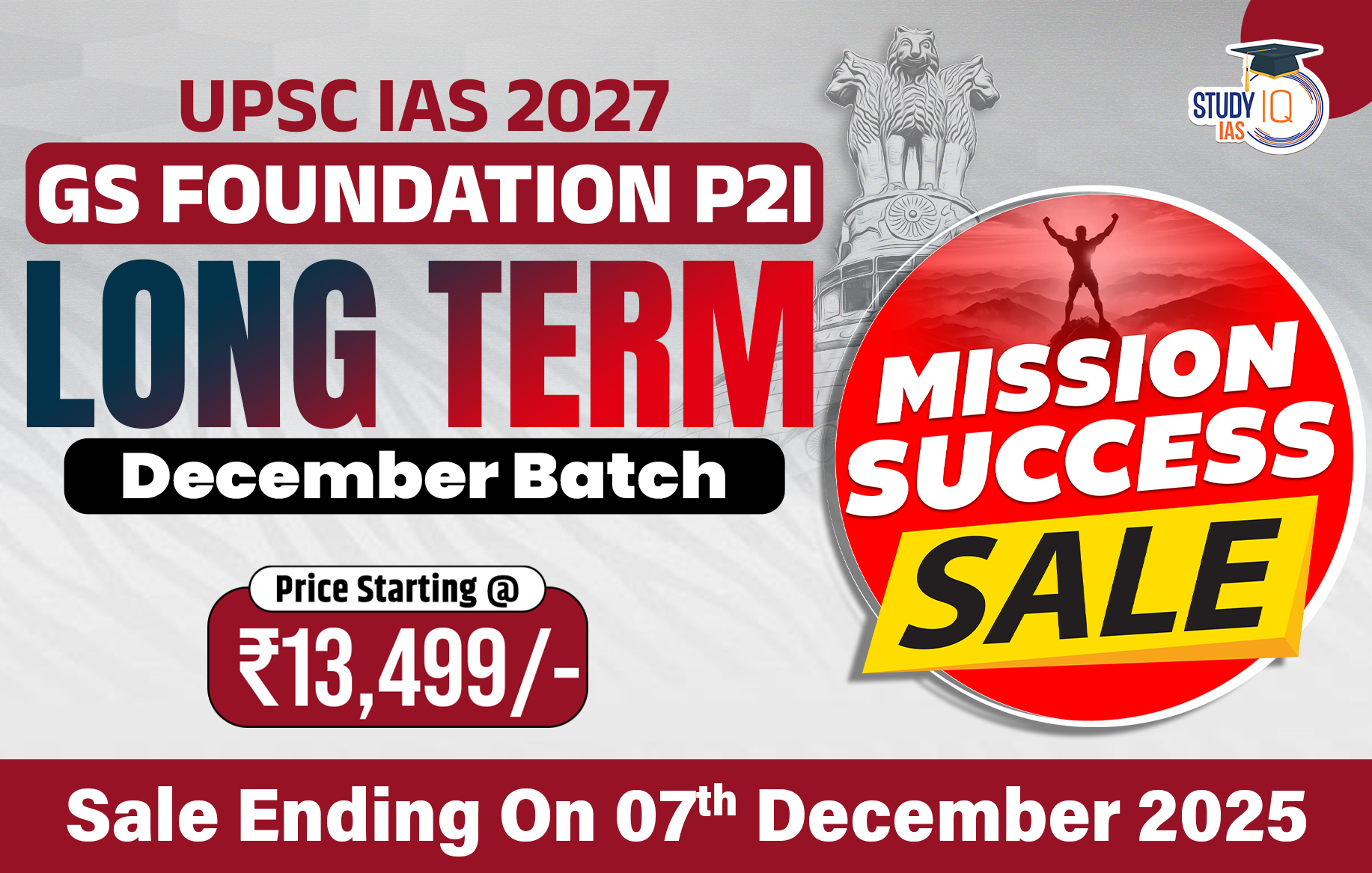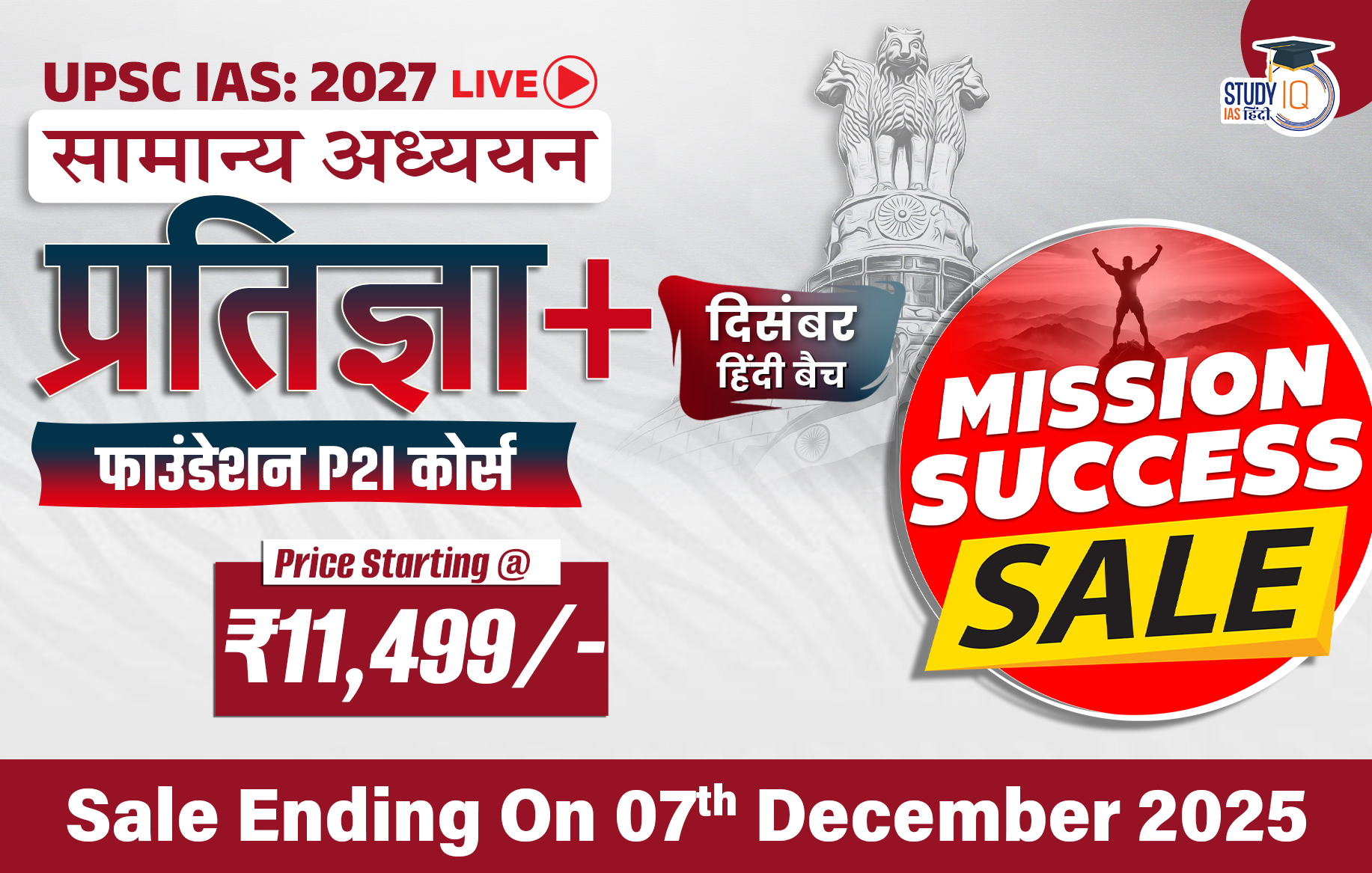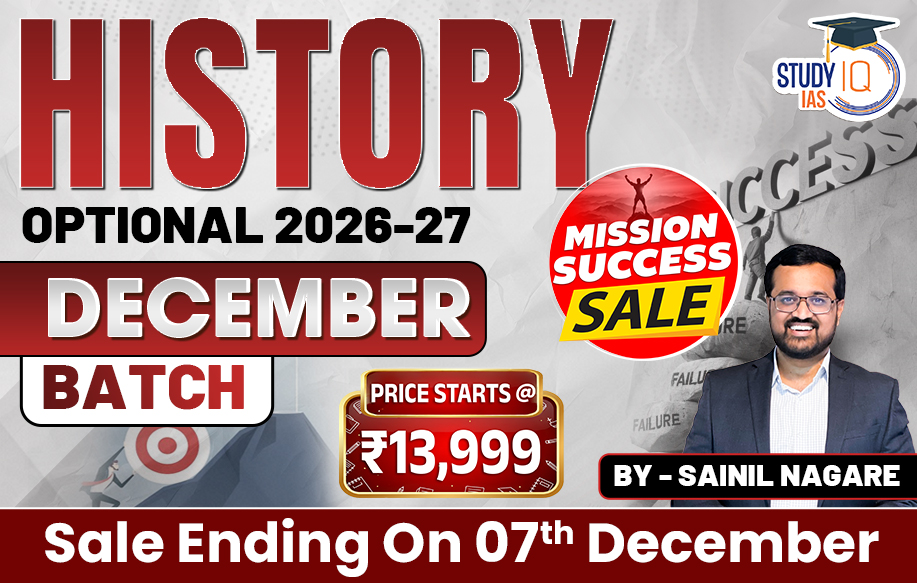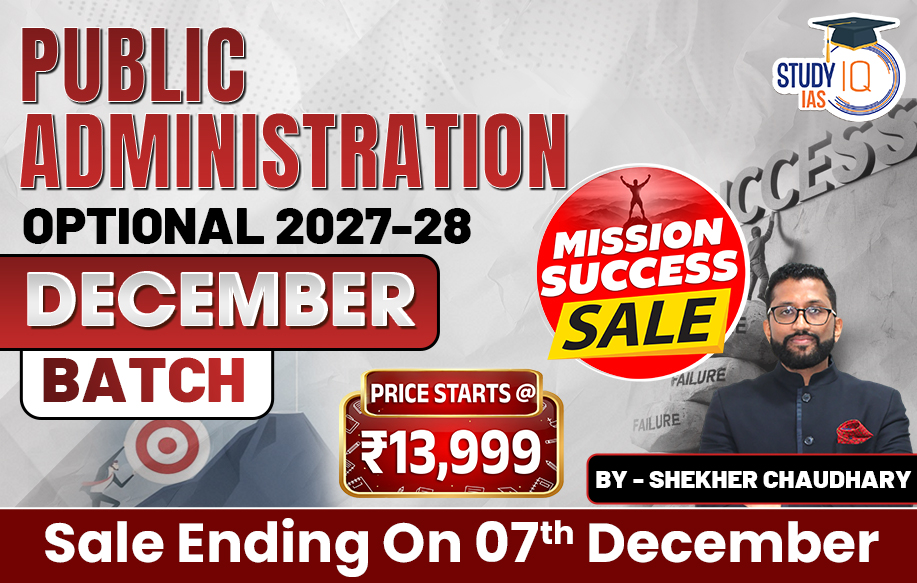Daily Quiz 3 December 2024
Quiz-summary
0 of 5 questions completed
Questions:
- 1
- 2
- 3
- 4
- 5
Information
- Click on – ‘Start Quiz’ button
- Solve Questions
- Click on ‘Next’ button
- Click on ‘Finish Quiz’ button
- Now click on ‘View Questions’ button – here you will see solutions and links.
- The test contains a total of 5 questions.
- Click on the most appropriate option to mark it as your answer.
- You will be awarded Two marks for each correct answer.
- You can change your answer by clicking on some other option.
- A Number list of all questions appears at the top side of the screen.
- You can access the questions in any order by clicking on the question number given on the number list.
- You can use rough sheets while taking the test.
- Do not use calculators, log tables, dictionaries, or any other printed/online reference material during the test.
- Do not click the button “Finish Quiz” before completing the test. A test once submitted cannot be resumed.
You have already completed the quiz before. Hence you can not start it again.
Quiz is loading...
You must sign in or sign up to start the quiz.
You have to finish following quiz, to start this quiz:
- 1
- 2
- 3
- 4
- 5
- Answered
- Review
-
Question 1 of 5
1. Question
1 pointsConsider the following statements with respect to the Mangalanatha Swamy Temple – Uthirakosamangai:
1. It is built-in the Dravidian style and features classic elements like Gopuram and Vimana.
2. The presiding deity here is Lord Vishnu in the name of Mangalanatha Swamy and his consort Laxmi as Mangalambigai
3. The temple has its mention in the hymns of 9th-century saint Manickavasagar.
Which of the following statements given above is/are correctCorrect
Answer: C
Explanation:
● Statement 1 is correct: Dravidian architecture, or the Southern Indian temple style, is an architectural idiom in Hindu temple architecture that emerged from Southern India. Sri Mangalnathswamy Temple in Tamil Nadu is built-in the Dravidian style, and the temple features classic elements like:
o Gopuram: Majestic gateway towers adorned with intricate sculptures.
o Vimana: The sanctum’s towering structure symbolizing divine presence.
o Mandapas: Pillared halls showcasing detailed carvings from Hindu mythology.
● Statement 2 is incorrect: This temple is located in Uthirakosamangai village, 15 km away from Ramanathapuram. The presiding deity here is Lord Shiva in the name of Mangalanatha Swamy and his consort Parvati as Mangalambigai. The construction of the temple was assumed to be initiated by the Pandya kings Achutappa Nayak, Muthuveerappan and other kings of Ramanthapuram at that time.
● Statement 3 is correct: The temple has its mention in the hymns of 9th-century saint Manickavasagar and 15th-century saint Arunagirinathar. The temple is believed to exist since 3000 years ago. This is the place where Lord Shiva transferred the taught Vedas to his consort Goddess Parvati. Thus the name Uthirakosamangai came to use.Incorrect
Answer: C
Explanation:
● Statement 1 is correct: Dravidian architecture, or the Southern Indian temple style, is an architectural idiom in Hindu temple architecture that emerged from Southern India. Sri Mangalnathswamy Temple in Tamil Nadu is built-in the Dravidian style, and the temple features classic elements like:
o Gopuram: Majestic gateway towers adorned with intricate sculptures.
o Vimana: The sanctum’s towering structure symbolizing divine presence.
o Mandapas: Pillared halls showcasing detailed carvings from Hindu mythology.
● Statement 2 is incorrect: This temple is located in Uthirakosamangai village, 15 km away from Ramanathapuram. The presiding deity here is Lord Shiva in the name of Mangalanatha Swamy and his consort Parvati as Mangalambigai. The construction of the temple was assumed to be initiated by the Pandya kings Achutappa Nayak, Muthuveerappan and other kings of Ramanthapuram at that time.
● Statement 3 is correct: The temple has its mention in the hymns of 9th-century saint Manickavasagar and 15th-century saint Arunagirinathar. The temple is believed to exist since 3000 years ago. This is the place where Lord Shiva transferred the taught Vedas to his consort Goddess Parvati. Thus the name Uthirakosamangai came to use. -
Question 2 of 5
2. Question
1 pointsConsider the following statements:
Statement-I:
High Altitude sickness is caused by the body’s exposure to low oxygen levels and reduced air pressure at high altitudes.
Statement-II
In response to the sickness, the body secretes a hormone which further causes the body to produce less red blood cells.
Which one of the following is correct in respect of the above statements?
Correct
Answer: C
Explanation:
- Statement I is correct: High Altitude Sickness is caused by the body’s exposure to low oxygen levels and reduced air pressure at high altitudes. It is also known as mountain sickness. As altitude increases, the air pressure and oxygen levels decrease, leading to hypoxia (shortage of oxygen in the body’s tissues). Altitude sickness is when your body doesn’t have time to adjust to lower oxygen availability higher up in the atmosphere. It’s usually preventable and treatable. When severe, it can rapidly turn into a life-threatening concern.
- Statement II is incorrect: At high altitudes and low oxygen levels, the kidneys sense an oxygen deficiency in the blood and respond by secreting a hormone called erythropoietin (EPO). EPO stimulates the bone marrow to accelerate the production of RBCs, so the RBC count rises.Therefore, when people are at high altitudes, their bodies produce more red blood cells (RBCs) to compensate for the lower oxygen levels in the lungs. This is a normal reaction to altitude sickness.
Incorrect
Answer: C
Explanation:
- Statement I is correct: High Altitude Sickness is caused by the body’s exposure to low oxygen levels and reduced air pressure at high altitudes. It is also known as mountain sickness. As altitude increases, the air pressure and oxygen levels decrease, leading to hypoxia (shortage of oxygen in the body’s tissues). Altitude sickness is when your body doesn’t have time to adjust to lower oxygen availability higher up in the atmosphere. It’s usually preventable and treatable. When severe, it can rapidly turn into a life-threatening concern.
- Statement II is incorrect: At high altitudes and low oxygen levels, the kidneys sense an oxygen deficiency in the blood and respond by secreting a hormone called erythropoietin (EPO). EPO stimulates the bone marrow to accelerate the production of RBCs, so the RBC count rises.Therefore, when people are at high altitudes, their bodies produce more red blood cells (RBCs) to compensate for the lower oxygen levels in the lungs. This is a normal reaction to altitude sickness.
-
Question 3 of 5
3. Question
1 pointsConsider the following statements with respect to the Central Value Added Tax or CENVAT:
- It allows a manufacturer to utilise the credit of excise duty to pay off the excise duty on the final productor output services.
- Under CENVAT, manufacturers donot get credit for the tax paid on raw materials but only for the input service.
Which of the statements given above is/are correct?
Correct
Answer: A
Explanation: The Supreme Court recently allowed telecom companies to claim Central Value Added Tax (CENVAT) credit for the installation of mobile towers and peripherals like prefabricated buildings (PFBs), for which they pay excise duties.
- Statement 1 is correct: Central Value Added Tax or CENVAT allows a manufacturer to utilise the credit of excise duty/additional duty paid for the procurement of input services to pay off the excise duty on his/her final product or output services. It was introduced as a modification to the previously functioning Modified Value Added Tax or MODVAT. In 2004, The government established ‘The CENVAT Credit Rules’ in order to implement CENVAT across the country and offer Indian manufacturers of final products certain tax credits on the excise duty payable by them.
- Statement 2 is incorrect: CENVAT credit refers to the set-off available to manufacturers if they utilise some specific inputs for manufacturing their products. A manufacturer can claim CENVAT credit on the following cases:
- Excise duty on a final product: For manufacturers and producers of final products.
- Service tax on output services: For providers of taxable and exempted services.
- Inputs and capital goods: If these goods are being partially processed.
Therefore, Under CENVAT, manufacturers get credit for the tax paid on raw materials, which they can later use to offset the excise duty they owe the tax department. CENVAT, therefore, eliminates this double taxation, thereby simplifying taxation for manufacturers and consumers at large.
Incorrect
Answer: A
Explanation: The Supreme Court recently allowed telecom companies to claim Central Value Added Tax (CENVAT) credit for the installation of mobile towers and peripherals like prefabricated buildings (PFBs), for which they pay excise duties.
- Statement 1 is correct: Central Value Added Tax or CENVAT allows a manufacturer to utilise the credit of excise duty/additional duty paid for the procurement of input services to pay off the excise duty on his/her final product or output services. It was introduced as a modification to the previously functioning Modified Value Added Tax or MODVAT. In 2004, The government established ‘The CENVAT Credit Rules’ in order to implement CENVAT across the country and offer Indian manufacturers of final products certain tax credits on the excise duty payable by them.
- Statement 2 is incorrect: CENVAT credit refers to the set-off available to manufacturers if they utilise some specific inputs for manufacturing their products. A manufacturer can claim CENVAT credit on the following cases:
- Excise duty on a final product: For manufacturers and producers of final products.
- Service tax on output services: For providers of taxable and exempted services.
- Inputs and capital goods: If these goods are being partially processed.
Therefore, Under CENVAT, manufacturers get credit for the tax paid on raw materials, which they can later use to offset the excise duty they owe the tax department. CENVAT, therefore, eliminates this double taxation, thereby simplifying taxation for manufacturers and consumers at large.
-
Question 4 of 5
4. Question
1 pointsConsider the following pairs of Indigenous people in news:
People Country
- Sami Norway
- Khoe-san Newzealand
- Maori South-Africa
How many of the pairs given above are correctly matched?
Correct
Answer: A
Explanation:
- Pair 1 is correctly matched: The Sami people are indigenous inhabitants of northern Norway, extending to parts of Sweden, Finland, and Russia. They have lived in this region for centuries, maintaining a distinct cultural identity tied to their environment. In a landmark move, the Norwegian Parliament formally apologized to the Sami, Forest Finn, and Oven people. The apology aimed to address historical and ongoing discrimination faced by these communities.
- Pair 2 is incorrectly matched: Collectively, the various African indigenous communities in South Africa are known as the Khoe-San / Khoisan, which comprises the San and the Khoekhoe. The main San groups include the San Khomani who reside mainly in the Kalahari region, and the Khwe and Xun, who reside primarily in Platfontein, Kimberley. The oldest surviving cultures in the region, the San were hunter-gatherers.
- Pair 3 is incorrectly matched: The indigenous people of New Zealand are the Māori. They are a Polynesian people who arrived in New Zealand in waves of canoe voyages between 1320 and 1350. Over time, they developed their own culture, language, mythology, crafts, and performing arts
Incorrect
Answer: A
Explanation:
- Pair 1 is correctly matched: The Sami people are indigenous inhabitants of northern Norway, extending to parts of Sweden, Finland, and Russia. They have lived in this region for centuries, maintaining a distinct cultural identity tied to their environment. In a landmark move, the Norwegian Parliament formally apologized to the Sami, Forest Finn, and Oven people. The apology aimed to address historical and ongoing discrimination faced by these communities.
- Pair 2 is incorrectly matched: Collectively, the various African indigenous communities in South Africa are known as the Khoe-San / Khoisan, which comprises the San and the Khoekhoe. The main San groups include the San Khomani who reside mainly in the Kalahari region, and the Khwe and Xun, who reside primarily in Platfontein, Kimberley. The oldest surviving cultures in the region, the San were hunter-gatherers.
- Pair 3 is incorrectly matched: The indigenous people of New Zealand are the Māori. They are a Polynesian people who arrived in New Zealand in waves of canoe voyages between 1320 and 1350. Over time, they developed their own culture, language, mythology, crafts, and performing arts
-
Question 5 of 5
5. Question
1 pointsConsider the following Acts of Parliament in India:
- The Hindu Adoption and Maintenance Act of 1956
- The Juvenile Justice (Care and Protection of Children) Act of 2015
Which of the above acts govern the process of adoption in India?
Correct
Answer: C
Explanation:
- Option (c) is correct: The adoption process in India is governed by two acts: the Hindu Adoption and Maintenance Act, 1956 (HAMA) and the Juvenile Justice Act, 2015. Hindu Adoption and Maintenance Act, 1956 governs the adoption process for Hindus, Buddhists, Jains, and Sikhs. To obtain adoption rights, a “dattaka hom” ceremony, adoption deed, or court order is required. Juvenile Justice Act, 2015 permits adoption across India, regardless of the religion of the adoptive parents or child. It also established the Central Adoption Resource Agency (CARA), which regulates in-country and inter-country adoptions. CARA is designated as the central authority for inter-country adoptions in accordance with the provisions of the Hague Convention on Inter-country Adoption, 1993.
Incorrect
Answer: C
Explanation:
- Option (c) is correct: The adoption process in India is governed by two acts: the Hindu Adoption and Maintenance Act, 1956 (HAMA) and the Juvenile Justice Act, 2015. Hindu Adoption and Maintenance Act, 1956 governs the adoption process for Hindus, Buddhists, Jains, and Sikhs. To obtain adoption rights, a “dattaka hom” ceremony, adoption deed, or court order is required. Juvenile Justice Act, 2015 permits adoption across India, regardless of the religion of the adoptive parents or child. It also established the Central Adoption Resource Agency (CARA), which regulates in-country and inter-country adoptions. CARA is designated as the central authority for inter-country adoptions in accordance with the provisions of the Hague Convention on Inter-country Adoption, 1993.
Results
0 of 5 questions answered correctly
Your time:
Time has elapsed
You have reached 0 of 0 points, (0)
| Average score |
|
| Your score |
|
Categories
- Not categorized 0%
| Pos. | Name | Entered on | Points | Result |
|---|---|---|---|---|
| Table is loading | ||||
| No data available | ||||
Sharing is caring!

 Daily Quiz 18 September 2025
Daily Quiz 18 September 2025

























